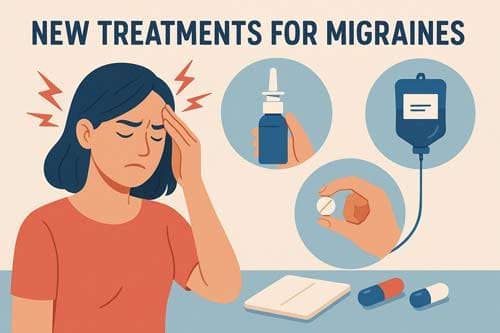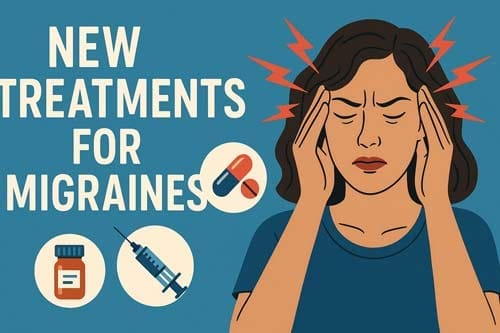New Treatments for Migraines: What Actually Works in 2025?

Introduction
Migraine affects approximately 10% of the global population, including 25% of adult women and 9% of children. It ranks as the third leading cause of years lived with disability, according to the 2019 Global Burden of Disease Study, and results in an estimated $13 billion in lost productivity annually in the U.S. alone. These figures underscore the urgent need for more effective, better-tolerated therapies. Since 2018, the treatment landscape for migraine has evolved significantly, driven by a deeper understanding of migraine pathophysiology, majorly the role of calcitonin gene-related peptide (CGRP).
Recent years have brought several groundbreaking therapies specifically designed to target migraine mechanisms. Among the most impactful are the CGRP monoclonal antibodies, which include:
- Eptinezumab (Vyepti)
- Erenumab (Aimovig)
- Fremanezumab (Ajovy)
- Galcanezumab (Emgality)
These biologics, approved by the FDA for migraine prevention, work by blocking the CGRP pathway, a key driver in migraine attacks. Unlike traditional migraine preventives, CGRP antibodies are migraine-specific and generally well tolerated, with fewer systemic side effects.
In addition to monoclonal antibodies, newer oral therapies known as gepants (e.g., ubrogepant, rimegepant, atogepant) and ditans (e.g., lasmiditan) have expanded treatment options. Gepants function as small-molecule CGRP receptor antagonists, effective for both acute and preventive treatment. Ditans, which act on serotonin 5-HT1F receptors, offer a non-vasoconstrictive alternative for acute management, particularly valuable for patients with cardiovascular risk.
Patients using these newer therapies frequently report meaningful clinical improvements, including reduced frequency and severity of attacks and, in many cases, extended headache-free periods. In response, the American Headache Society now recommends CGRP-targeting therapies as first-line options for eligible patients, supporting broader adoption and access.
This article reviews the most effective migraine treatments available in 2025, focusing on their mechanisms of action, clinical evidence, and their role in modern migraine management. These innovations represent a major step forward in addressing the unmet needs of millions living with migraine.
New Oral Medications for Migraine Relief
Oral medications represent a major breakthrough in the newest migraine medications available today. These treatments target calcitonin gene-related peptide (CGRP), a key protein involved in migraine pathophysiology.
Zavegepant (Zavzpret): Nasal spray for acute attacks
Zavegepant is the first and only CGRP receptor antagonist available as a nasal spray for acute migraine treatment. The medication delivers relief with a single 10 mg spray in one nostril [1]. Clinical studies demonstrate that Zavzpret can provide pain freedom in 2 hours, with some patients experiencing relief in as little as 15 minutes [1]. Notably, 59.3% of patients treated with this new treatment for migraine headaches reported returning to normal function within 30 minutes [1]. Common side effects include unusual taste, nausea, nasal discomfort, and vomiting, while severe allergic reactions, though rare, may occur [1].
Atogepant (Qulipta): Daily preventive therapy
Atogepant stands out among new migraine medications as a once-daily oral preventive treatment. Clinical trials have demonstrated that patients taking atogepant experienced 3.7-4.2 fewer migraine days per month compared to 2.5 days with placebo [2]. The medication is available in multiple doses (10 mg, 30 mg, and 60 mg), with efficacy observed across all dosages [2]. Moreover, atogepant begins working early in treatment, with measurable improvements seen within the first four weeks [3]. The most common side effects include constipation (6.1%), nausea (6.6%), and upper respiratory tract infection (5.3%) [4].
Rimegepant (Nurtec ODT): Dual-use dissolvable tablet
Rimegepant represents a breakthrough as the first new migraine treatment approved for both acute treatment and prevention. As a 75 mg orally disintegrating tablet, Nurtec ODT provides acute relief with 59.3% of patients experiencing pain relief at 2 hours compared to 43.3% with placebo [5]. For prevention, when taken every other day, patients experienced 4.3 fewer monthly migraine days during weeks 9-12 [5]. In long-term studies, 83% of users preferred rimegepant to their prior medication [6]. Safety data shows the treatment is well-tolerated with infrequent adverse events (14.8%) [6].
Ubrogepant (Ubrelvy): Fast-acting oral option
Ubrogepant offers fast-acting relief as a new treatment for migraines in acute attacks. Available in 50 mg and 100 mg tablets, clinical trials showed 19.2% and 21.2% of patients, respectively, achieved freedom from pain at 2 hours compared to 11.8% with placebo [7]. Additionally, pain relief was reported by 60.7% (50 mg) and 61.4% (100 mg) of patients at 2 hours versus 49.1% with placebo [7]. Research indicates that ubrogepant can be detected in the bloodstream within 11 minutes after ingestion, with pain relief beginning within 1 hour [8]. Common side effects include nausea, drowsiness, and dry mouth [9].

CGRP Monoclonal Antibodies: Preventive Innovations
Monoclonal antibodies targeting calcitonin gene-related peptide (CGRP) represent a revolutionary approach among new treatments for migraines, focusing on prevention rather than symptom management. These specialized medications block either CGRP itself or its receptors, interfering with the cascade of events leading to migraine attacks.
Eptinezumab (Vyepti): Intravenous quarterly infusion
Eptinezumab, the first and only FDA-approved intravenous treatment for migraine prevention, offers unique advantages through its delivery method. Administered as a 30-minute infusion every three months, eptinezumab reaches maximum plasma concentration at the end of infusion [10]. This rapid bioavailability enables onset of action within 24 hours—reducing migraine likelihood by more than 50% during the first day after administration [11]. In clinical trials, treatment with eptinezumab compared to placebo shortened the median time to headache pain freedom (4 hours vs. 9 hours) and time to absence of most bothersome symptom (2 hours vs. 3 hours) [10]. The most common side effect reported is mild nasal symptoms.
Fremanezumab (Ajovy): Monthly or quarterly injection
Fremanezumab offers flexible dosing options with either monthly 225mg injections or quarterly 675mg doses via subcutaneous self-administration [12]. Clinical trials demonstrated 30-50% of patients experienced reduction in migraine days by at least half [12]. Furthermore, patients with episodic migraine showed increased headache-free days with normal functional performance in work, household chores, and concentration measures compared to baseline [13]. The medication can be delivered through prefilled syringes or autoinjectors [14].
Galcanezumab (Emgality): Also approved for cluster headache
Galcanezumab stands apart among newest migraine medications as the only CGRP antibody approved for both migraine prevention and episodic cluster headache [15]. In cluster headache trials, more than 70% of patients receiving 300mg experienced at least 50% reduction in weekly attacks by week 3 [16]. For episodic cluster headache, the condition typically ended approximately 17.3 days after administration [17]. In migraine prevention, galcanezumab has demonstrated long-term effectiveness in improving functional impairment and reducing disability [18].
Erenumab (Aimovig): First CGRP-targeted antibody
Erenumab made history as the first FDA-approved CGRP antagonist in 2018 [19]. Unlike other monoclonal antibodies that target CGRP itself, erenumab uniquely blocks the CGRP receptor [20]. In clinical trials, patients receiving 140mg reported a 50% decrease in migraine days per week during the first week of use [18]. The medication is administered monthly via self-injection with an autoinjector system [21]. Common side effects include injection-site reactions, constipation, and upper respiratory infections [22]

Non-Drug Devices for Migraine Management
Non-pharmacological interventions have emerged as vital components in the armamentarium of new treatments for migraines, offering options for patients who cannot tolerate or prefer to avoid medications.
Nerivio: Smartphone-controlled armband
Nerivio represents a breakthrough as the first FDA-cleared Remote Electrical Neuromodulation (REN) wearable for both prevention and acute treatment of migraine. This armband device, worn on the upper arm, stimulates peripheral nerves to trigger the brain’s natural pain inhibition system called Conditioned Pain Modulation (CPM) [23]. Clinical studies demonstrate impressive efficacy with 7 out of 10 patients achieving pain relief [23]. After two months of preventive use, patients experienced a reduction of 4 migraine days per month, with over 50% reporting at least a 50% reduction in moderate to severe headache days [23]. Recently, Nerivio became the first non-pharmacological migraine treatment to receive commercial insurance coverage in the United States [24]. The device is approved for patients as young as 8 years old, making it more valuable for pediatric migraine management [23].
Relivion MG: Dual-nerve stimulation headband
The Relivion MG system, FDA-cleared in March 2021, functions as a headband that simultaneously stimulates six branches of the occipital and trigeminal nerves [25]. This dual-pathway approach makes it the only non-invasive device targeting both nerve systems implicated in migraine pathophysiology [25]. In clinical trials, 46% of users achieved pain freedom at two hours without rescue medication versus 11.8% with a sham device [25]. Furthermore, 76% reported headache relief at two hours compared to 31.8% in the control group [1]. The device connects to a smartphone application that tracks treatment data and shares insights with healthcare providers [25]. Available by prescription, Relivion offers a 90-day trial program for $200, with subsequent financing options starting at $75 monthly [1].
HeadaTerm 2: Forehead TENS device for prevention
HeadaTerm 2, recently cleared by the FDA as an over-the-counter option, delivers targeted electrical nerve stimulation through a forehead-worn device [26]. This transcutaneous electrical nerve stimulation (TENS) technology acts on the supraorbital and supratrochlear nerves that transmit migraine pain [26]. Clinical data shows the TENS group experienced a mean visual analog scale change from 0 to 120 minutes of -65 ± 25 compared to -9 ± 2 for the sham group [26]. Priced at $99.99, HeadaTerm 2 offers a considerably more affordable alternative to similar technologies like Cefaly, which costs $389-$424 [27]. The simplified one-button design requires no app interface, enhancing accessibility for diverse user groups [27].
Other Notable Advances in Migraine Therapy
Beyond CGRP-targeted therapies and non-drug devices, several innovative treatments have emerged to address gaps in migraine management through distinct mechanisms and delivery systems.
Lasmiditan (Reyvow): Non-vasoconstrictive acute treatment
Lasmiditan represents the first “ditan” class medication, selectively targeting 5-HT1F receptors without causing vasoconstriction due to its low affinity for 5-HT1B receptors. This makes it suitable for patients with cardiovascular risk factors who cannot take triptans. In pivotal SAMURAI and SPARTAN trials, patients taking lasmiditan achieved headache pain freedom at 2 hours (32.2% with 200mg and 28.2% with 100mg) versus 15.3% with placebo [28]. Despite its effectiveness, lasmiditan can cause CNS-related effects, primarily dizziness. Therefore, patients should not drive for at least 8 hours after taking each dose [29].
Trudhesa: DHE nasal spray with new delivery system
Trudhesa utilizes Precision Olfactory Delivery technology to administer dihydroergotamine to the highly vascularized upper nasal space. In contrast to lower nasal delivery systems, this approach provides consistent absorption and predictable therapeutic effects. Exploratory results from a 24-week study demonstrated that some patients experienced relief as early as 15 minutes, with more than half reporting freedom from their most bothersome symptom at 2 hours [2]. Furthermore, 85% of attacks treated did not require a second dose, and the therapy showed similar effectiveness regardless of when it was taken during an attack [2].
Onzetra Xsail: Sumatriptan nasal powder
Onzetra Xsail employs Breath Powered delivery to administer sumatriptan powder directly to the posterior nasal cavity. This innovative system proves valuable for morning migraines, which account for 48% of attacks occurring between 4AM and 9AM [3]. Clinical studies showed twice as many patients achieved pain freedom at 2 hours compared to placebo (34% vs 17%) [4]. The design limits medication from dripping into the throat, enhancing absorption through the nasal tissue’s abundant blood vessels [4].
Elyxyb: Liquid NSAID for acute migraine
Elyxyb, a ready-to-use oral solution of celecoxib, employs a self-micro emulsifying drug delivery system enabling faster absorption. Approved in 2020, this liquid NSAID works within one hour to provide migraine relief [30]. The recommended dose is 120mg taken orally with or without food, with a maximum of one dose per 24-hour period [31]. As with other NSAIDs, Elyxyb carries risks of cardiovascular and gastrointestinal adverse events, thus it should not be used more than 2-3 times weekly to avoid medication overuse headache [32].


Conclusion
The landscape of migraine treatment has evolved significantly since 2018, offering patients more effective, better-tolerated, and personalized options for both acute and preventive care. Historically, treatment relied on medications repurposed from other conditions, often yielding suboptimal results with notable side effects. The advent of CGRP-targeted therapies has reshaped this paradigm, introducing a new era of migraine-specific interventions (Goadsby et al., 2021).
Oral gepants, such as rimegepant and atogepant, have emerged as dual-purpose agents, suitable for both prevention and acute relief. They offer improved tolerability and comparable efficacy to older therapies (Croop et al., 2019). Monoclonal antibodies, though administered via injection or infusion, deliver long-acting protection with minimal systemic effects and convenient dosing schedules, monthly or quarterly (Ashina et al., 2022).
In parallel, non-pharmacological neuromodulation devices like Nerivio and Relivion MG represent a novel, non-invasive treatment class. These are particularly beneficial for individuals who are pregnant, pediatric patients, or those with contraindications to medication. While they may not match the efficacy of drug therapies across all populations, they fill critical gaps in migraine management (Rapoport et al., 2023).
The expanding range of treatment options enables clinicians to tailor therapy to each patient’s needs, considering factors such as migraine frequency, comorbidities, lifestyle, and treatment preferences. However, barriers persist especially regarding affordability and insurance coverage. Furthermore, a substantial proportion of patients with chronic migraine (30–40%) remain inadequately responsive to existing therapies (Dodick et al., 2024).
Future directions must focus on identifying biomarkers to guide individualized treatment, advancing therapies for refractory cases, and improving affordability and access. As research deepens our understanding of migraine pathophysiology, upcoming therapies are expected to move beyond CGRP inhibition, unlocking new targets and bringing hope to patients still underserved by current options.
Frequently Asked Questions:
FAQs
Q1. What are the most effective new treatments for migraines in 2025? The most effective new treatments include CGRP-targeted therapies such as oral gepants (rimegepant, atogepant), monoclonal antibodies (eptinezumab, erenumab, fremanezumab, galcanezumab), and non-drug devices like Nerivio and Relivion MG. These options offer both preventive and acute management with fewer side effects than traditional treatments.
Q2. How do the new CGRP monoclonal antibodies work for migraine prevention? CGRP monoclonal antibodies work by blocking either the CGRP protein itself or its receptors, disrupting the cascade of events that lead to migraine attacks. They are administered through injections or infusions on a monthly or quarterly basis, providing long-lasting preventive effects with minimal side effects.
Q3. Are there any non-medication options for managing migraines? Yes, several non-drug devices have been developed for migraine management. These include Nerivio, a smartphone-controlled armband that uses electrical stimulation, Relivion MG, a headband that stimulates occipital and trigeminal nerves, and HeadaTerm 2, a forehead TENS device for prevention. These options are particularly useful for patients who prefer to avoid medications.
Q4. What are the advantages of the new oral medications for migraine relief? New oral medications like rimegepant and atogepant offer dual functionality for both prevention and acute treatment of migraines. They demonstrate superior tolerability compared to traditional options while maintaining comparable efficacy rates. Some, like Zavegepant, are available as nasal sprays for faster relief.
Q5. How soon can patients expect relief from these new migraine treatments? The onset of relief varies depending on the treatment. Some acute treatments, like Zavegepant nasal spray, can provide relief in as little as 15 minutes. Preventive treatments like CGRP monoclonal antibodies may take a few weeks to show full effect, but some patients report improvements within the first week of treatment.

References:
[1] – https://www.migrainedisorders.org/relivion-migraine-neuromodulation-device/
[2] – https://www.migrainedisorders.org/migraine-treatment-exploring-the-applications-of-dhe-in-the-upper-nasal-space/
[3] – https://www.onzetrahcp.com/
[4] – https://www.onzetra.com/
[5] – https://www.nurtec.com/
[6] – https://practicalneurology.com/news/rimegepant-dual-treatment-efficacy-and-safety-maintained-over-a-year-of-treatment
[7] – https://www.nejm.org/doi/full/10.1056/NEJMoa1813049
[8] – https://www.healthline.com/health/drugs/how-long-does-ubrelvy-take-to-work
[9] – https://medlineplus.gov/druginfo/meds/a620016.html
[10] – https://jamanetwork.com/journals/jama/fullarticle/2781053
[11] – https://www.migrainedisorders.org/podcast/s4ep6-eptinezumab-for-migraine-prevention/
[12] – https://www.cuh.nhs.uk/patient-information/fremanezumab-for-the-prevention-of-chronic-migraine-autoinjector-pen/
[13] – https://pmc.ncbi.nlm.nih.gov/articles/PMC6161555/
[14] – https://www.medicalnewstoday.com/articles/326054
[15] – https://www.nejm.org/doi/full/10.1056/NEJMoa1813440
[16] – https://thejournalofheadacheandpain.biomedcentral.com/articles/
10.1186/s10194-022-01505-w
[17] – https://pubmed.ncbi.nlm.nih.gov/36321947/
[18] – https://pmc.ncbi.nlm.nih.gov/articles/PMC9997852/
[19] – https://www.ajmc.com/view/fda-approves-erenumab-first-cgrp-inhibitor-for-prevention-of-migraine
[20] – https://consultqd.clevelandclinic.org/cgrp-inhibitors-for-migraine-prevention-what-prescribers-need-to-know
[21] – https://www.nature.com/articles/nbt0718-559b
[22] – https://pubmed.ncbi.nlm.nih.gov/30813769/
[23] – https://www.nerivio.com/
[24] – https://practicalneurology.com/news/wearable-device-for-migraine-treatment-receives-commercial-coverage-in-the-united-states
[25] – https://patient9.com/medical-device/relivion-mg-medical-device-review-tech-enabled-migraine-relief/
[26] – https://www.empr.com/home/news/medical-technology/otc-device-headaterm-2-cleared-prophylactic-treatment-of-episodic-migraine/
[27] – https://www.migraineagain.com/headaterm-2-device-approved-for-migraine-prevention/
[28] – https://thejournalofheadacheandpain.biomedcentral.com/
articles/10.1186/s10194-019-1044-6
[29] – https://www.tandfonline.com/doi/abs/10.2217/pmt-2021-0002
[30] – https://www.drugs.com/elyxyb.html
[31] – https://www.elyxyb.com/savings-dosing/
[32] – https://www.migraineagain.com/elyxyb-celecoxib-oral-solution-migraine/

